定语从句和状语从句语法点总结
- 格式:doc
- 大小:56.50 KB
- 文档页数:5
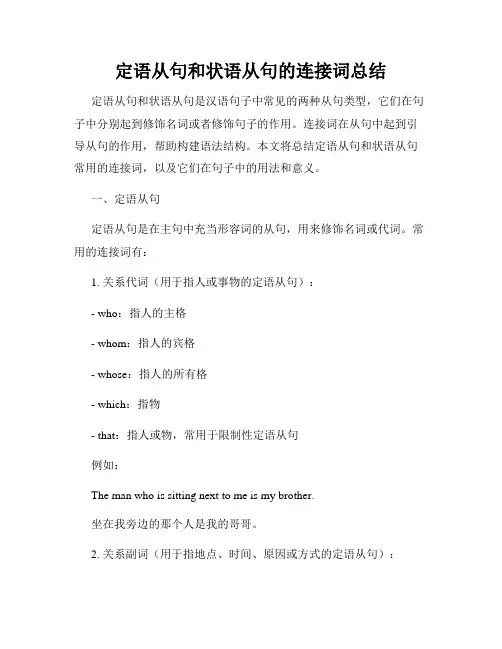
定语从句和状语从句的连接词总结定语从句和状语从句是汉语句子中常见的两种从句类型,它们在句子中分别起到修饰名词或者修饰句子的作用。
连接词在从句中起到引导从句的作用,帮助构建语法结构。
本文将总结定语从句和状语从句常用的连接词,以及它们在句子中的用法和意义。
一、定语从句定语从句是在主句中充当形容词的从句,用来修饰名词或代词。
常用的连接词有:1. 关系代词(用于指人或事物的定语从句):- who:指人的主格- whom:指人的宾格- whose:指人的所有格- which:指物- that:指人或物,常用于限制性定语从句例如:The man who is sitting next to me is my brother.坐在我旁边的那个人是我的哥哥。
2. 关系副词(用于指地点、时间、原因或方式的定语从句):- where:指地点- when:指时间- why:指原因- how:指方式例如:This is the city where I was born.这是我出生的城市。
二、状语从句状语从句用来修饰整个句子或主句的成分,并提供更多的信息。
常用的连接词有:1. 引导时间状语从句的连接词:- when:当…的时候- while:当…时候- as soon as:一…就- before:在…之前- after:在…之后- until:直到例如:I will call you when I arrive.我到达时会给你打电话。
2. 引导条件状语从句的连接词:- if:如果- unless:除非- provided that:只要例如:If it rains, we will stay at home.如果下雨,我们将呆在家里。
3. 引导原因状语从句的连接词:- because:因为- since:因为- as:因为- now that:既然例如:I didn't go to the party because I was busy.我没去参加聚会,因为我很忙。
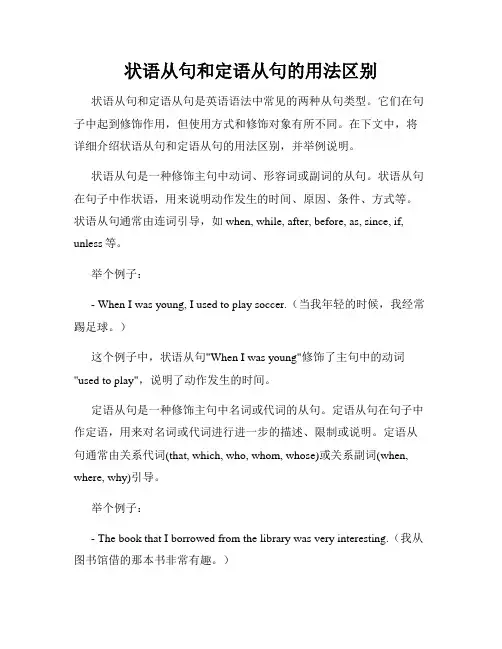
状语从句和定语从句的用法区别状语从句和定语从句是英语语法中常见的两种从句类型。
它们在句子中起到修饰作用,但使用方式和修饰对象有所不同。
在下文中,将详细介绍状语从句和定语从句的用法区别,并举例说明。
状语从句是一种修饰主句中动词、形容词或副词的从句。
状语从句在句子中作状语,用来说明动作发生的时间、原因、条件、方式等。
状语从句通常由连词引导,如when, while, after, before, as, since, if, unless等。
举个例子:- When I was young, I used to play soccer.(当我年轻的时候,我经常踢足球。
)这个例子中,状语从句"When I was young"修饰了主句中的动词"used to play",说明了动作发生的时间。
定语从句是一种修饰主句中名词或代词的从句。
定语从句在句子中作定语,用来对名词或代词进行进一步的描述、限制或说明。
定语从句通常由关系代词(that, which, who, whom, whose)或关系副词(when, where, why)引导。
举个例子:- The book that I borrowed from the library was very interesting.(我从图书馆借的那本书非常有趣。
)这个例子中,定语从句"that I borrowed from the library"修饰了主句中的名词"book",对其进行了进一步的说明。
状语从句和定语从句的区别主要体现在以下几个方面:1. 功能不同:- 状语从句用来表示动作发生的时间、原因、条件、方式等,对主句中的动词、形容词或副词进行修饰;- 定语从句用来对主句中的名词或代词进行描述、限制或说明。
2. 引导词不同:- 状语从句由连词引导,如when, while, after, before, as, since, if, unless等;- 定语从句由关系代词或关系副词引导,如that, which, who, whom, whose, when, where, why等。
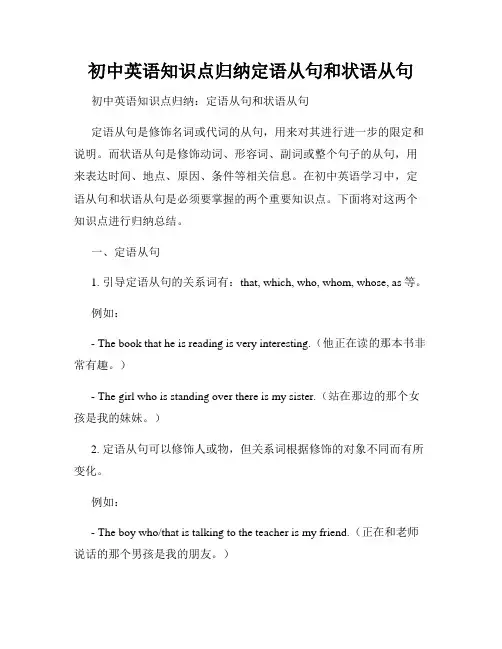
初中英语知识点归纳定语从句和状语从句初中英语知识点归纳:定语从句和状语从句定语从句是修饰名词或代词的从句,用来对其进行进一步的限定和说明。
而状语从句是修饰动词、形容词、副词或整个句子的从句,用来表达时间、地点、原因、条件等相关信息。
在初中英语学习中,定语从句和状语从句是必须要掌握的两个重要知识点。
下面将对这两个知识点进行归纳总结。
一、定语从句1. 引导定语从句的关系词有:that, which, who, whom, whose, as等。
例如:- The book that he is reading is very interesting.(他正在读的那本书非常有趣。
)- The girl who is standing over there is my sister.(站在那边的那个女孩是我的妹妹。
)2. 定语从句可以修饰人或物,但关系词根据修饰的对象不同而有所变化。
例如:- The boy who/that is talking to the teacher is my friend.(正在和老师说话的那个男孩是我的朋友。
)- The book which/that I borrowed from the library is very interesting.(我从图书馆借的那本书非常有趣。
)3. 当定语从句修饰整个句子时,使用关系副词where, when, why等引导。
例如:- I still remember the day when we first met.(我仍然记得我们第一次见面的那一天。
)- The reason why he is late is that his car broke down.(他迟到的原因是他的车出了故障。
)4. 在定语从句中,关系代词的宾格形式whom用于修饰人,它可以用于作为宾语,而who则既可以作主语也可以作宾语。
例如:- The teacher whom you met yesterday is my English teacher.(你昨天遇见的那位老师是我的英语老师。
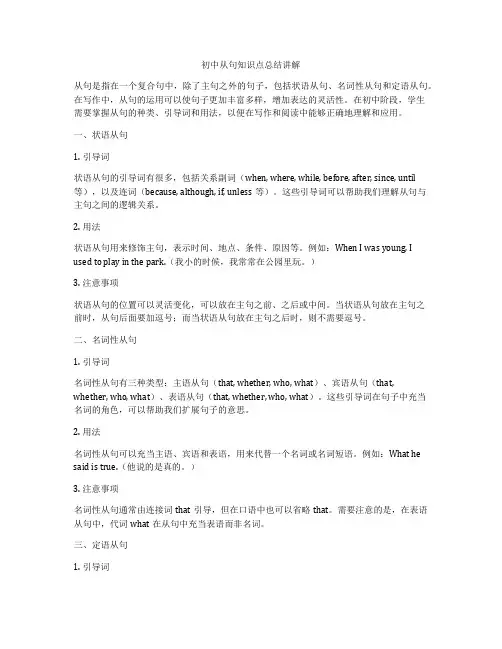
初中从句知识点总结讲解从句是指在一个复合句中,除了主句之外的句子,包括状语从句、名词性从句和定语从句。
在写作中,从句的运用可以使句子更加丰富多样,增加表达的灵活性。
在初中阶段,学生需要掌握从句的种类、引导词和用法,以便在写作和阅读中能够正确地理解和应用。
一、状语从句1. 引导词状语从句的引导词有很多,包括关系副词(when, where, while, before, after, since, until 等),以及连词(because, although, if, unless等)。
这些引导词可以帮助我们理解从句与主句之间的逻辑关系。
2. 用法状语从句用来修饰主句,表示时间、地点、条件、原因等。
例如:When I was young, I used to play in the park.(我小的时候,我常常在公园里玩。
)3. 注意事项状语从句的位置可以灵活变化,可以放在主句之前、之后或中间。
当状语从句放在主句之前时,从句后面要加逗号;而当状语从句放在主句之后时,则不需要逗号。
二、名词性从句1. 引导词名词性从句有三种类型:主语从句(that, whether, who, what)、宾语从句(that, whether, who, what)、表语从句(that, whether, who, what)。
这些引导词在句子中充当名词的角色,可以帮助我们扩展句子的意思。
2. 用法名词性从句可以充当主语、宾语和表语,用来代替一个名词或名词短语。
例如:What he said is true.(他说的是真的。
)3. 注意事项名词性从句通常由连接词that引导,但在口语中也可以省略that。
需要注意的是,在表语从句中,代词what在从句中充当表语而非名词。
三、定语从句1. 引导词定语从句的引导词包括关系代词(who, whom, whose, which, that)和关系副词(when, where, why)。
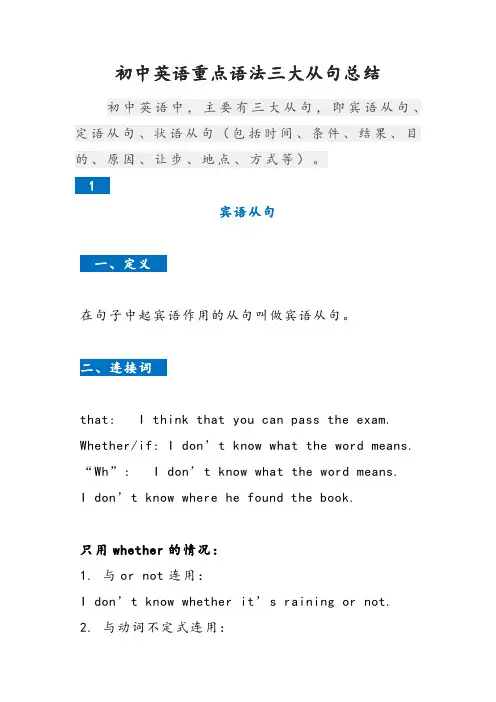
初中英语重点语法三大从句总结初中英语中,主要有三大从句,即宾语从句、定语从句、状语从句(包括时间、条件、结果、目的、原因、让步、地点、方式等)。
1宾语从句在句子中起宾语作用的从句叫做宾语从句。
that: I think that you can pass the exam. Whether/if: I don’t know what the word means. “Wh”: I don’t know what the word means.I don’t know where he found the book.只用whether的情况:1. 与or not连用:I don’t know whether it’s raining or not.2. 与动词不定式连用:He doesn’t know whether to accept the invitation.3. 连接词前有介词时:It depends on whether he is coming.1. 主句是一般现在时态,从句根据实际情况而定(各种时态均可)She wants to know what he has done for the exam.2.主句是一般过去时态,从句用相应的过去的时态。
1)She said that she was a student.2)She said that she would fly to Japan in a week. 3)She said that she had finished her homework already.3. 如果宾语从句说的是客观真理、自然现象或事实时,这时宾语从句要用一般现在时态。
The teacher said that the earth goes round the sun.2定语从句在复合句中修饰名词、代词的从句叫定语从句。
先行词指人 who /that先行词指物 which/ that定语从句一般紧跟被修饰的名词或代词(即先行词)后关系代词代替先行词在句子中担当成分,所以从句中不可再出现其他代替先行词的代词Whom: 先行词指人,则代替先行词在定语从句中充当宾语(包括介词的宾语), 与who的区别是如果前面带介词则必须用whom1. This is the teacher whomwho we like best.2. I don’t like the boy to whom you are talking.Whose :指人或物,作定语,表示“…的”eg: Harry is the boy whose mother is our math teacher.关系代词只能 that 的特殊情况:1.先行词前有序数词修饰时:This is the first gift that my parents bought me.2.先行词前有形容词最高级修饰时:This is the most exciting film that I have ever seen.3. 先行词是不定代词something, anything等时.e.g. Is there anything that you want i n this shop4. 先行词是人和物时, 用that.e.g.He talked about some writers and books that were unknown to us all.5. 先行词被all , little , the only , the very(就是,正是), the last 等词修饰时,只能用thate.g. This is the last place that I want to visit.6. 特殊疑问句以who 或which 开头,只能用that引导.Who is the girl that is making a speech on the platform?当关系代词前使用介词时:物+介词+which ; 人+ 介词 + whom当关系代词前使用介词时:e.g. 1. This is the train by which we went to Beijing.2. This is the teacher to whom my mother is talking.3状语从句在复合句中由从句表示的状语称作状语从句,它可以用来修饰谓语(包括非谓语动词)、定语或状语,或是整个句子。
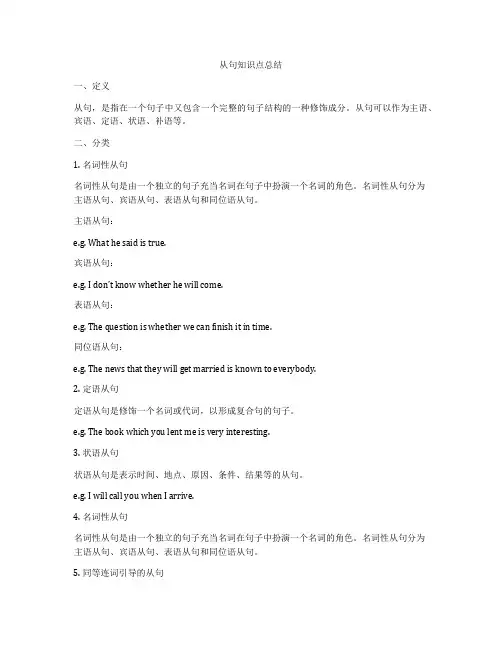
从句知识点总结一、定义从句,是指在一个句子中又包含一个完整的句子结构的一种修饰成分。
从句可以作为主语、宾语、定语、状语、补语等。
二、分类1. 名词性从句名词性从句是由一个独立的句子充当名词在句子中扮演一个名词的角色。
名词性从句分为主语从句、宾语从句、表语从句和同位语从句。
主语从句:e.g. What he said is true.宾语从句:e.g. I don’t know whether he will come.表语从句:e.g. The question is whether we can finish it in time.同位语从句:e.g. The news that they will get married is known to everybody.2. 定语从句定语从句是修饰一个名词或代词,以形成复合句的句子。
e.g. The book which you lent me is very interesting.3. 状语从句状语从句是表示时间、地点、原因、条件、结果等的从句。
e.g. I will call you when I arrive.4. 名词性从句名词性从句是由一个独立的句子充当名词在句子中扮演一个名词的角色。
名词性从句分为主语从句、宾语从句、表语从句和同位语从句。
5. 同等连词引导的从句有时从句可以由“ as, since, while, when, because”等连词引导。
三、从句的语序1. 主语从句的语序如果主语从句是一般疑问句,那么主语从句的语序是正常的一般疑问句语序,即“疑问词 + 谓语 + 主语 + 其他”。
如果主语从句是陈述句,那么主语从句的语序是一般陈述句语序,即“主语+ 谓语+ 其他”。
2. 宾语从句的语序宾语从句的语序根据主句而定。
如果主句是陈述句或肯定句,则宾语从句的语序与原陈述句语序一致;如果主句是疑问句,那么宾语从句的语序是陈述句语序,即“主语 + 谓语 +宾语 + 其他”。
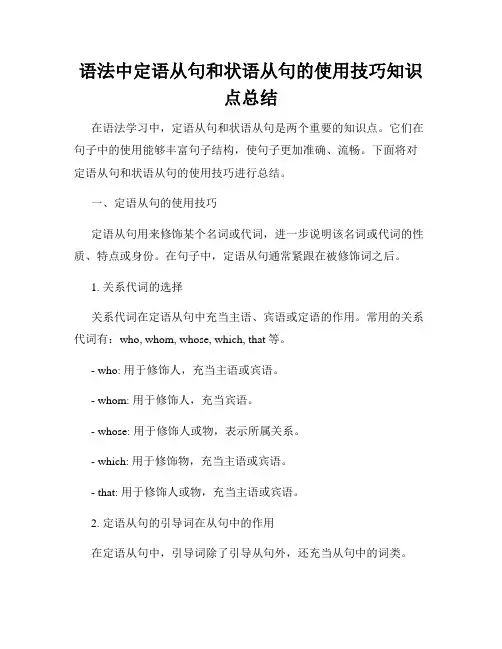
语法中定语从句和状语从句的使用技巧知识点总结在语法学习中,定语从句和状语从句是两个重要的知识点。
它们在句子中的使用能够丰富句子结构,使句子更加准确、流畅。
下面将对定语从句和状语从句的使用技巧进行总结。
一、定语从句的使用技巧定语从句用来修饰某个名词或代词,进一步说明该名词或代词的性质、特点或身份。
在句子中,定语从句通常紧跟在被修饰词之后。
1. 关系代词的选择关系代词在定语从句中充当主语、宾语或定语的作用。
常用的关系代词有:who, whom, whose, which, that等。
- who: 用于修饰人,充当主语或宾语。
- whom: 用于修饰人,充当宾语。
- whose: 用于修饰人或物,表示所属关系。
- which: 用于修饰物,充当主语或宾语。
- that: 用于修饰人或物,充当主语或宾语。
2. 定语从句的引导词在从句中的作用在定语从句中,引导词除了引导从句外,还充当从句中的词类。
- who/whom: 引导定语从句时,作为主谓语、宾语等。
- whose: 引导定语从句时,作为所属关系的名词修饰词。
- which: 引导定语从句时,作为主谓语、宾语等。
- that: 引导定语从句时,作为主谓语、宾语等。
3. 定语从句的位置定语从句通常紧跟在被修饰词之后,但也可以放在句末。
需要注意的是,当被修饰的词是某些特定词时,定语从句应放在句首。
- 特定词包括:something, anything, nothing, all, much, little, only等。
二、状语从句的使用技巧状语从句用来修饰动词、形容词、副词或整个句子,表示时间、地点、原因、目的、条件、方式等方面的信息。
状语从句通常以连词引导,放在主句前或后。
1. 时间状语从句时间状语从句用来表示动作发生的时间。
常用的引导词有:when, while, as, before, after, since, until等。
- When I was a child, I used to play football every day.- I will wait for you until you finish your work.2. 地点状语从句地点状语从句用来表示动作发生的地点。
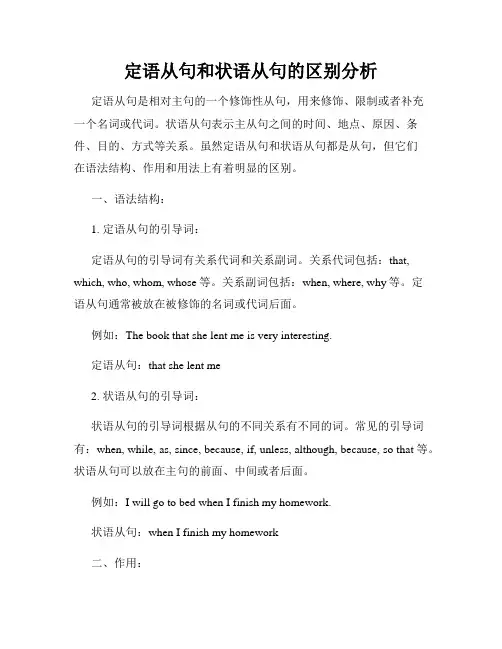
定语从句和状语从句的区别分析定语从句是相对主句的一个修饰性从句,用来修饰、限制或者补充一个名词或代词。
状语从句表示主从句之间的时间、地点、原因、条件、目的、方式等关系。
虽然定语从句和状语从句都是从句,但它们在语法结构、作用和用法上有着明显的区别。
一、语法结构:1. 定语从句的引导词:定语从句的引导词有关系代词和关系副词。
关系代词包括:that, which, who, whom, whose等。
关系副词包括:when, where, why等。
定语从句通常被放在被修饰的名词或代词后面。
例如:The book that she lent me is very interesting.定语从句:that she lent me2. 状语从句的引导词:状语从句的引导词根据从句的不同关系有不同的词。
常见的引导词有:when, while, as, since, because, if, unless, although, because, so that等。
状语从句可以放在主句的前面、中间或者后面。
例如:I will go to bed when I finish my homework.状语从句:when I finish my homework二、作用:1. 定语从句的作用:定语从句用来修饰或者限制名词或代词,进一步说明名词或代词的特征、性质或身份。
例如:The girl who is wearing a red dress is my sister.定语从句:who is wearing a red dress2. 状语从句的作用:状语从句表示主句中的动作发生的时间、地点、原因、条件、目的、方式等情况。
它与主句之间是一种逻辑上的因果、条件、时间等关系。
例如:I will go to the park if it doesn't rain tomorrow.状语从句:if it doesn't rain tomorrow三、用法:1. 定语从句的用法:定语从句用来修饰名词或者代词,通常紧跟在被修饰的名词或代词之后。
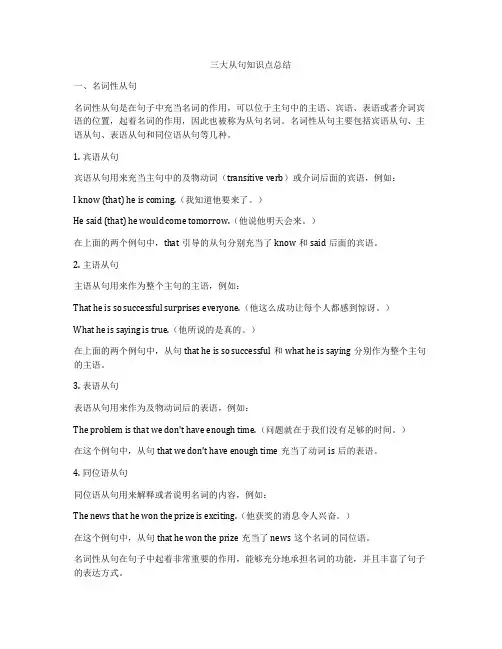
三大从句知识点总结一、名词性从句名词性从句是在句子中充当名词的作用,可以位于主句中的主语、宾语、表语或者介词宾语的位置,起着名词的作用,因此也被称为从句名词。
名词性从句主要包括宾语从句、主语从句、表语从句和同位语从句等几种。
1. 宾语从句宾语从句用来充当主句中的及物动词(transitive verb)或介词后面的宾语,例如:I know (that) he is coming.(我知道他要来了。
)He said (that) he would come tomorrow.(他说他明天会来。
)在上面的两个例句中,that引导的从句分别充当了know和said后面的宾语。
2. 主语从句主语从句用来作为整个主句的主语,例如:That he is so successful surprises everyone.(他这么成功让每个人都感到惊讶。
)What he is saying is true.(他所说的是真的。
)在上面的两个例句中,从句that he is so successful和what he is saying分别作为整个主句的主语。
3. 表语从句表语从句用来作为及物动词后的表语,例如:The problem is that we don't have enough time.(问题就在于我们没有足够的时间。
)在这个例句中,从句that we don't have enough time充当了动词is后的表语。
4. 同位语从句同位语从句用来解释或者说明名词的内容,例如:The news that he won the prize is exciting.(他获奖的消息令人兴奋。
)在这个例句中,从句that he won the prize充当了news这个名词的同位语。
名词性从句在句子中起着非常重要的作用,能够充分地承担名词的功能,并且丰富了句子的表达方式。
二、定语从句定语从句用来修饰名词或代词,对其进行进一步的说明或者限定,增加句子的信息量。
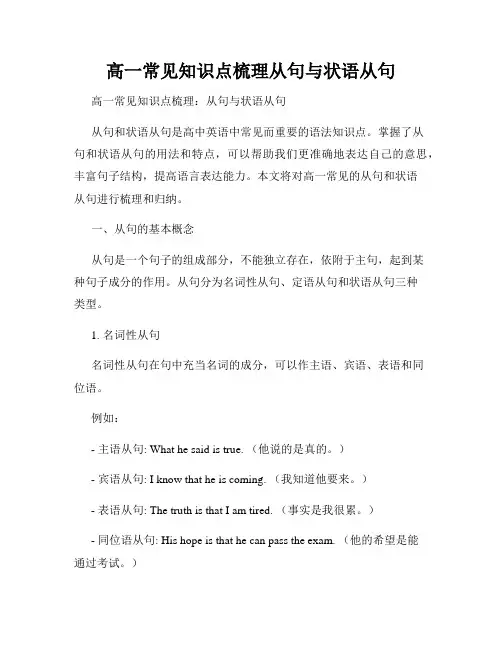
高一常见知识点梳理从句与状语从句高一常见知识点梳理:从句与状语从句从句和状语从句是高中英语中常见而重要的语法知识点。
掌握了从句和状语从句的用法和特点,可以帮助我们更准确地表达自己的意思,丰富句子结构,提高语言表达能力。
本文将对高一常见的从句和状语从句进行梳理和归纳。
一、从句的基本概念从句是一个句子的组成部分,不能独立存在,依附于主句,起到某种句子成分的作用。
从句分为名词性从句、定语从句和状语从句三种类型。
1. 名词性从句名词性从句在句中充当名词的成分,可以作主语、宾语、表语和同位语。
例如:- 主语从句: What he said is true. (他说的是真的。
)- 宾语从句: I know that he is coming. (我知道他要来。
)- 表语从句: The truth is that I am tired. (事实是我很累。
)- 同位语从句: His hope is that he can pass the exam. (他的希望是能通过考试。
)2. 定语从句定语从句用来修饰名词或代词,相当于一个形容词。
关系代词引导定语从句。
例如:- The book that I borrowed from the library is very interesting. (我从图书馆借来的那本书非常有趣。
)3. 状语从句状语从句用来表示时间、原因、条件、方式、结果等,相当于一个副词。
常用的连接词有when、because、if、how、so等。
例如:- When you finish your homework, you can go out to play. (当你完成作业时,你可以出去玩。
)- He failed the exam because he didn't study hard. (他考试不及格是因为他没有努力学习。
)- If it rains tomorrow, we will stay indoors. (如果明天下雨,我们就呆在室内。
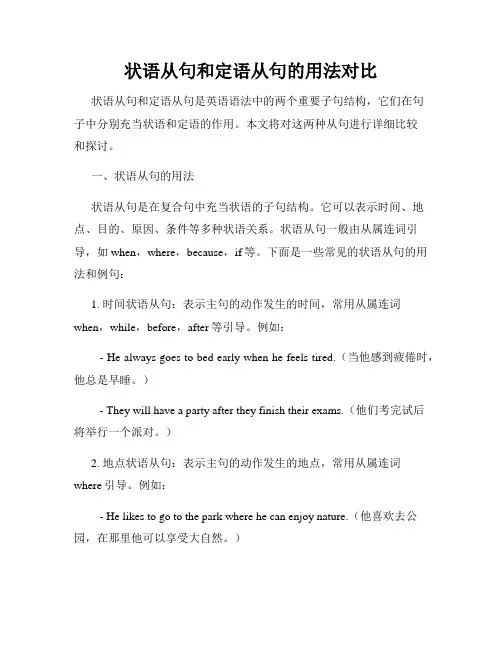
状语从句和定语从句的用法对比状语从句和定语从句是英语语法中的两个重要子句结构,它们在句子中分别充当状语和定语的作用。
本文将对这两种从句进行详细比较和探讨。
一、状语从句的用法状语从句是在复合句中充当状语的子句结构。
它可以表示时间、地点、目的、原因、条件等多种状语关系。
状语从句一般由从属连词引导,如when,where,because,if等。
下面是一些常见的状语从句的用法和例句:1. 时间状语从句:表示主句的动作发生的时间,常用从属连词when,while,before,after等引导。
例如:- He always goes to bed early when he feels tired.(当他感到疲倦时,他总是早睡。
)- They will have a party after they finish their exams.(他们考完试后将举行一个派对。
)2. 地点状语从句:表示主句的动作发生的地点,常用从属连词where引导。
例如:- He likes to go to the park where he can enjoy nature.(他喜欢去公园,在那里他可以享受大自然。
)3. 原因状语从句:表示引起主句动作的原因,常用从属连词because,since,as等引导。
例如:- They couldn't come to the party because they were busy.(因为他们很忙,所以不能参加派对。
)4. 目的状语从句:表示主句动作的目的,常用从属连词so that,in order that引导。
例如:- He studies hard so that he can get a good grade.(他努力学习,以便能得到一个好成绩。
)5. 条件状语从句:表示在什么条件下主句的动作才会发生,常用从属连词if,unless,provided等引导。
例如:- If it rains tomorrow, we will stay at home.(如果明天下雨,我们会呆在家里。
高中语法从句知识点总结一、名词性从句1. 主语从句:主语从句在句子中充当主语的角色,常用引导词有that, whether/if, what等。
例如:What you said is true.(你说的是真的。
)2. 宾语从句:宾语从句在句子中充当宾语的角色,常用引导词有that, whether/if, what, who, whom, whose, which, when, where等。
例如:I don't know what he wants.(我不知道他想要什么。
)3. 表语从句:表语从句在句子中充当表语的角色,常用引导词有that, whether/if, what等。
例如:The problem is whether we should go or not.(问题是我们是否应该去。
)4. 定语从句:定语从句用来修饰名词或代词,常用引导词有that, which, who, whom, whose等。
例如:The book that I borrowed from the library is very interesting.(我从图书馆借的那本书很有趣。
)二、状语从句1. 时间状语从句:时间状语从句用来表示动作发生的时间,常用引导词有when, while, as, before, after, since, until, as soon as等。
例如:I will call you as soon as I arrive.(我一到就给你打电话。
)2. 地点状语从句:地点状语从句用来表示动作发生的地点,常用引导词有where, wherever等。
例如:I will go wherever you go.(无论你去哪里,我都会跟着去。
)3. 原因状语从句:原因状语从句用来表示动作的原因,常用引导词有because, since, as, now that等。
例如:She didn't come because she was sick.(她没来是因为她生病了。
定语从句与状语从句的区别与联系定语从句和状语从句都是从属从句,用来修饰主句中的名词或句子。
它们在语法结构和功能上有一些区别和联系。
本文将介绍定语从句和状语从句的区别和联系,以便更好地理解和使用它们。
一、定语从句定语从句是用来修饰名词或代词的从句,在句中作定语,起到限定或说明名词或代词的作用。
下面是一些定语从句的特点:1. 位置:定语从句通常紧跟在被修饰的名词或代词后面,形成一个整体修饰名词或代词。
2. 引导词:定语从句的引导词有关系代词和关系副词两种形式。
关系代词包括:who, whom, which, that, whose等;关系副词包括:when, where, why等。
3. 功能:定语从句起到对名词或代词的补充和说明作用,进一步限定名词或代词的意义。
例句:The book that you lent me is very interesting.二、状语从句状语从句是用来修饰动词、形容词、副词或整个句子的从句,它在句中并不起限定名词的作用,而是用来说明动作、状态或条件等。
下面是一些状语从句的特点:1. 位置:状语从句可以位于主句的前面、中间或后面,用来修饰整个句子或其中的部分成分。
2. 引导词:状语从句的引导词有一些特定的词汇,比如:when, while, before, after, since, as, although, because等。
3. 功能:状语从句起到对动作、状态或条件的说明和补充作用。
例句:He went to bed early because he was tired.三、区别与联系虽然定语从句和状语从句都是从属从句,但在功能和位置上有一些区别:1. 功能区别:定语从句用来修饰名词或代词,起到对其进行补充和限定的作用;而状语从句用来修饰动词、形容词、副词或整个句子,对动作、状态或条件进行说明和补充。
2. 位置区别:定语从句紧跟在被修饰的名词或代词后面,形成一个整体;状语从句可以位于句子的前面、中间或后面,用来修饰整个句子或其中的部分成分。
状语从句和定语从句的区别状语从句和定语从句是英语语法中常用的两种从句类型,它们在句子中扮演不同的角色,并且有一些明显的区别。
本文将详细讨论状语从句和定语从句之间的区别。
一、状语从句状语从句是一种从属于主句的从句,用来修饰主句中的动词、形容词、副词或整个句子。
状语从句通常表达时间、条件、原因、目的、方式和结果等与主句之间的关系。
以下是状语从句的一些特点:1. 位置:状语从句通常位于主句之前或之后,并且被逗号、引号或连词连接。
2. 功能:状语从句常常用来表达时间、条件、原因、目的、方式和结果等。
3. 结构:状语从句的引导词包括常见的连词如when, while, if, because, so that等。
举例来说,以下是一些状语从句的使用:- 时间状语从句:When I arrived, they were already eating dinner.(当我到达时,他们已经在吃晚饭了。
)- 条件状语从句:If it rains tomorrow, we will stay indoors.(如果明天下雨,我们将呆在室内。
)- 原因状语从句:Because she studied hard, she passed the exam.(因为她努力学习,所以她通过了考试。
)- 目的状语从句:I bought some snacks so that we can enjoy them during the movie.(我买了一些零食,这样我们可以在看电影时享用。
)- 方式状语从句:He speaks as if he knows everything.(他说话的样子好像什么都知道。
)- 结果状语从句:The baby was crying, so I picked her up.(婴儿在哭,所以我抱起了她。
)二、定语从句定语从句也是一种从属于主句的从句,用来修饰主句中的名词或代词。
定语从句通常提供额外的信息,对主句中的名词或代词进行限定或描述。
列举英语语法状语从句的归纳总结(优秀3篇)目的状语从句,从句部分是用以补充说明主句中谓语动词发生的目的的状语从句。
下面是壶知道敬业的帮助大家分享的3篇列举英语语法状语从句的归纳总结,欢迎参考阅读,希望对大家有所启发。
. 状语从句:Adverbial clauses 篇一定义:在复合句中由从句表示的`状语称作状语从句,它可以用来修饰谓语(包括非谓语动词)、定语或状语,或是整个句子。
状语从句一般分为八大类时间状语从句地点状语从句原因状语从句目的状语从句结果状语从句条件状语从句方式状语从句让步状语从句1、时间状语从句When ---当……时候,通常指某一特定的时间点,主句与从句的动作同时发生。
When I opened the window, I saw him e up. When ---正在……的时候,突然…。
通常主句是进行时或be about to 时,在翻译的时候,when 可以译成没想到或突然。
I was walking along the street ,when I met hiWhen 当从句是进行时,主句是一般时,往往表示不满。
Someone knocked at the door when I was having breakfast. When=afterWhen the children had gone to bed, she began to prepare her lessons. While ---在……期间,往往指一段时间。
While we were in America, we saw him twice.While ---表示一种不满情绪,意思是这边在干某种重要的事,而另一边在享受等。
We are cleaning the classroom while they are playing the football. As ---一边……一边,随着She was doing her homework as she was listening to the music.As ---当……时,指一个动作紧接着一个动作发生,从句通常用进行时。
语法解析定语从句和状语从句定语从句是英语中非常重要的语法结构之一,它能够进一步修饰名词或代词,从而使整个句子更加丰满、清晰。
在定语从句中,引导词起到连接定语从句与主句的作用,同时还可以表示一个人或物的身份、性质、数量等。
状语从句则是在主句中起状语作用的从句结构。
一、定语从句定语从句通常由关系代词(that, who, whom, whose, which)或关系副词(when, where, why)引导。
关系代词引导的定语从句可作主语、宾语、表语和定语等,而关系副词引导的定语从句则是修饰前面一个句子或句子成分。
(1)关系代词引导的定语从句1. 关系代词“that”在定语从句中作主语时,无论先行词是人还是物,均可使用。
例句1:The book that is on the desk is mine.这本在桌子上的书是我的。
2. 关系代词“who”和“whom”用来引导修饰人的定语从句,其中“who”作为主语,而“whom”作为宾语。
例句2:The girl who is sitting next to me is my sister.坐在我旁边的那个女孩是我的姐姐。
例句3:The man whom I met yesterday is an engineer.我昨天遇到的那个人是一名工程师。
3. 关系代词“whose”用来修饰名词或代词,并且表示所修饰的名词或代词所属的人或物。
例句4:This is the company whose CEO is my uncle.这是我叔叔担任CEO的公司。
4. 关系代词“which”用于引导修饰物的定语从句。
例句5:The computer which I bought last week is very fast.我上周购买的那台电脑非常快。
(2)关系副词引导的定语从句1. 关系副词“when”用来引导时间状语从句,修饰时间。
例句6:I still remember the day when we first met.我仍然记得我们第一次见面的那天。
专四语法考点串讲之四:定语从句关系代词:which(指sth 作主语或宾语),that(指sb或sth 作主语或宾语),who(指sb 作主语或宾语),whom(指sb作宾语),whose(指sb或sth,作定语),as(指sb,sth 作主语或宾语); 注意: 做宾语的时候,关系代词可以省略。
关系副词:when(指时间on which),where(指地点at which),why(指原因for which)考点1. 先行词为人时引导词who和that(1) 只能用who不用that:1)当先行词为one(s), anyone, those时;2)当先行词为人称代词时。
(2) 只能用that不用who:1)当主句已经出现who时。
2)关系代词在定语从句中作表语时。
1. He is quite worn out from years of hard work. He is not the man _______ he was twenty years ago. 2003A. whichB. thatC. whoD. whom考点2. 先行词为物时引导词that和which(1) 只能用that不用which:1)先行词为much, little, few, nothing, none, anything, no, all等不定代词。
2)先行词既有人又有物。
3)先行词被形容词的最高级或序数词修饰。
4)先行词被the very, the only, the last, just, all, any, every, no等修饰。
5)关系代词在从句中作表语。
6) 在疑问词who、which、what开头的句子中。
7) 主句是there be句型。
1. I was very interested in _____ she told me.2009A. all thatB. all whichC. all whatD. That2. Firms that use computers have found that the number of staff ____is needed for quality control can be substantially reduced. 2000A. whoseB. asC. whatD. that3. The team can handle whatever _____. (1997)A. that needs handlingB. which needs handlingC. it needs handlingD. needs to be handled4. There is no one in the world ______.1991A. that ever made mistakesB. that has ever made mistakesC. that never makes mistakesD. that sometimes makes mistakes(2) 只能用which不用that: 1) 定语从句中的介词前臵时关系代词只能用which; 2)引导非限制性定语从句时只能用which,其先行词可是一个词, 也可是整个主句或主句的某一部分。
1. They overcame all the difficulties and completed the project two months ahead of time, _____is something we had not expected. 2003A. whichB. itC. thatD. what2. We’ve just installed two air-conditioners in our apartment, ____should make great differences in our life next summer.2002A. whichB. whatC. thatD. They3. The physicist has made a discovery, _____of great importance to the progress of science and technology.1997A. I think which isB. that I think isC. which I think isD. which I think it is考点3:介词+关系代词(which/ whom)(1) 关系代词前介词的确定方法:定语从句的动词与先行词的逻辑关系,或者从句的动词、形容词的习惯性搭配。
1. The party, __I was the guest of honour, was extremely enjoyable.2006A. by whichB. for whichC. to whichD. at which2. I’ve never been to Lhasa, but that’s the c ity _______.1999A. I’d most like to visitB. which I like to visit mostlyC. where I like to visitD. I’d like much to visit3. The Clarks haven’t decided yet which hotel_______. 1998A. to stayB. is to stayC. to stay atD. is for staying4.I have never been to London, but that is the city ________.1997A. where I like to visit mostB. I'd most like to visit.C. which I like to visit mostlyD. where I'd like most to visit(2) 非限制性定语从句中,表示先行词的一部分时,可用“数词/代词+of+关系代词”的结构;(3) Whose从句可转换为“ of +关系代词”型,whose的先行词指物时, 可用of which代替, 但词序不同,即whose+n=the +n + of which =of which + the + n.1. Above the trees are the hills, _______ magnificence the river faithfully reflects on the surface.2003A. whereB. of whoseC. whoseD. which考点4:关系副词的运用⑴先行词为“时间的名词”用when1. She remembered several occasions in the past ____she had experienced a similar feeling.1998A. whichB. beforeC. thatD. when⑵先行词为“表示地点的名词”(case, point, situation, condition, scene, stage, country, room, house, hotel, museum, school, street等)用where1. Have you ever been in a situation _____ you know the other person is right yet you cannot agree with him?2002A. by whichB. thatC. in whereD. Where2. This company has now introduced a policy _____pay rises have related to performance at work. 1996A. whichB. whereC. whetherD. what⑶先行词为“表示原因的名词”why:reason+why…(表示原因的名词只有一个)考点5:as与which引导的定语从句as 放在句首句中都可以,which 必需放在句中,但下列情况多用as: 1) 关系代词引导的定语从句居句首时。
2) 当与such as或the same连用时,一般用as。
3) 当主句和从句之间存在着逻辑上的因果关系时,关系词往往只用which。
1. Only take these clothes ______really necessary.1994A. as wereB. as they areC. as they wereD. as are2. _____ is often the case with a new idea, much preliminary activity and optimistic discussion produced no concrete proposals. 1994A. ThatB. ItC. ThisD. As三大注意:1. the way 做先行词时,定语从句可由that, in which 引导或不用引导词。
2. 定语从句中主谓一致问题:从句中的动词在人称和数方面应该与它的先行词保持一致。
He is one of the teachers who know English well.He is the only one of the teachers who knows English well.(特殊)3.疑问句的解题思路:先把疑问句还原成陈述句,然后判断谁是先行词,再看关系词在定语从句中所充当的成分,最后确定正确答案。
专四语法考点串讲之五:状语从句考点1:时间状语从句连接词:when, while, as, till/until, before, after, since, once, as soon as, every time, the moment, the minute, no sooner ..than hardly…when等(1) whenever1. Come and see me whenever _____. (1997)A. you are convenientB. you will be convenientC. it is convenient to youD. it will be convenient to you(2) No sooner than/ hardly ..when/ scarcely..when 一.就..用于句首要求倒装1. The couple had no sooner got to the station _____ the coach left.2009A. whenB. asC. untilD. Than(3) 其它1. I enjoyed myself so much ____ I visited my friends in Paris last year. 2008A. whenB. whichC. thatD. where2. __ the Atlantic Ocean cross the equator, the trade winds cause a flow of water to the west. (1991)A. ThatB. WhenC. WhereD. Though考点2:条件状语从句连接词:if , unless so/as long as, on condition that(条件是),as (so) far as (据..所知), provided that(要是,如果),in case(假使,如果),only if(只有)等(2) only if只有1.____ both sides accept the agreement ____ a lasting peace be established in this region.2004A. Only if, willB. If only, wouldC. Should, willD. U nless, would(3) unless 除非1. You won’t get a loan ______ you can offer some security.1996A. lestB. in caseC. unlessD. other than2. ___ I was very much mistaken, there was something wrong with Louise. 1995A. UnlessB. AsC. ThoughD. Since3. _____ their policy can be changed the future for that country will be indeed bleak. (1993)A. Even ifB. UnlessC. Now thatD. As long as4. We could go to a concert _____ you’d prefer to visit a museum. (1992)A. ifB. becauseC. unlessD. since考点3:原因状语从句连接词:Because, since, as (放句首) , for, now that(既然,由于), when(既然), considering that (顾及到---), seeing that(由于)。